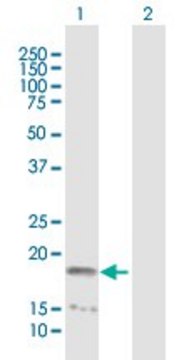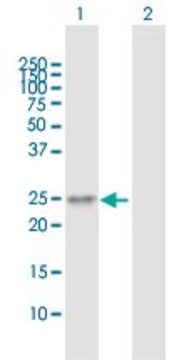SAB1408731
Anti-NME6 antibody produced in mouse
purified immunoglobulin, buffered aqueous solution
Synonym(s):
IPIA-ALPHA, NM23-H6
About This Item
biological source
mouse
Quality Level
conjugate
unconjugated
antibody form
purified immunoglobulin
antibody product type
primary antibodies
clone
polyclonal
form
buffered aqueous solution
mol wt
antigen 22 kDa
species reactivity
human
technique(s)
western blot: 1 μg/mL
1 of 4
This Item | SAB1401266 | SAB1406656 | SAB1408365 |
|---|---|---|---|
| biological source mouse | biological source mouse | biological source mouse | biological source mouse |
| conjugate unconjugated | conjugate unconjugated | conjugate unconjugated | conjugate unconjugated |
| antibody form purified immunoglobulin | antibody form purified immunoglobulin | antibody form purified immunoglobulin | antibody form purified immunoglobulin |
| Quality Level 100 | Quality Level 100 | Quality Level 100 | Quality Level 100 |
| form buffered aqueous solution | form buffered aqueous solution | form buffered aqueous solution | form buffered aqueous solution |
| storage temp. −20°C | storage temp. −20°C | storage temp. −20°C | storage temp. −20°C |
General description
Immunogen
Sequence
MTQNLGSEMASILRSPQALQLTLALIKPDAVAHPLILEAVHQQILSNKFLIVRMRELLWRKEDCQRFYREHEGRFFYQRLVEFMASGPIRAYILAHKDAIQLWRTLMGPTRVFRARHVAPDSIRGSFGLTDTRNTTHGSDSVVSASREIAAFFPDFSEQRWYEEEEPQLRCGPVCYSPEGGVHYVAGTGGLGPA
Physical form
Not finding the right product?
Try our Product Selector Tool.
Storage Class
10 - Combustible liquids
wgk_germany
WGK 3
flash_point_f
Not applicable
flash_point_c
Not applicable
Choose from one of the most recent versions:
Certificates of Analysis (COA)
Don't see the Right Version?
If you require a particular version, you can look up a specific certificate by the Lot or Batch number.
Already Own This Product?
Find documentation for the products that you have recently purchased in the Document Library.
Related Content
Cyclic nucleotides, including cyclic AMP (cAMP), cyclic GMP (cGMP) and cyclic ADP-ribose, have been extensively studied as second messengers of intracellular events initiated by activation of GPCRs. cAMP modifies cell function in all eukaryotic cells, principally through the activation of cAMP-dependent protein kinase (PKA), but also through cAMP-gated ion channels and guanine nucleotide exchange factors directly activated by cAMP.
Our team of scientists has experience in all areas of research including Life Science, Material Science, Chemical Synthesis, Chromatography, Analytical and many others.
Contact Technical Service


